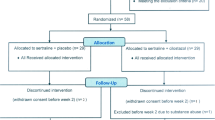Abstract
Background: The aim of this study was to determine remission rates during treatment with two different dosages of milnacipran, and the effect of milnacipran therapy for at least 1 year on the maintenance of remission and tolerability, in outpatients with major depression.
Methods: The study included 41 outpatients with major depression who initially received milnacipran 50 mg/day for 1–2 weeks, followed by a dosage increase to 100 mg/day for 12 weeks. Patients who achieved remission (17-item Hamilton Depression Rating Scale [HDRS] scores ≤7) after 12 weeks of milnacipran 100 mg/day treatment continued at the same dosage and were followed for at least 1 year. For patients who had decreased HDRS scores, but failed to attain remission, the dosage of milnacipran was increased to 150 mg/day, and those who achieved remission were then followed for at least 1 year.
Results: Eight out of 41 patients were withdrawn from the study prematurely because of adverse events (eight events in six patients: nausea, thirst, urinary discomfort, rapid pulse, palpitations, staggering sensation or sweating) or as a result of the patient’s decision (two patients). Thirteen (31.7%) of 41 patients achieved remission during treatment with milnacipran 100 mg/day. Of the remaining 20 patients, 17 underwent a dosage increase to 150 mg/day, and 13 achieved remission at a second assessment (cumulative remission rate: 63.4%). No adverse events or recurrence of symptoms were found in any of the patients who achieved remission during the subsequent follow-up period of a minimum of 1 year.
Conclusions: The results of this study showed milnacipran 150 mg/day and 100 mg/day to be effective and well tolerated in the long-term treatment of outpatients with major depression, and indicated that a dosage of 150 mg/day is an effective therapeutic option for depression when a dosage of 100 mg/day does not provide a satisfactory response.





Similar content being viewed by others
References
Montgomery SA, Prost JF, Solles A, et al. Efficacy and tolerability of milnacipran: an overview. Int Clin Psychopharmacol 1996; 11Suppl. 4: 47–51
Fukuchi T, Kanemoto K. Differential effects of milnacipran and fluvoxamine, especially in patients with severe depression and agitated depression: a case-control study. Int Clin Psychopharmacol 2002; 17(2): 53–8
Morishita S, Arita S. Differential period of onset of action of fluvoxamine, paroxetine and milnacipran for depression. Hum Psychopharmacol 2003; 18(6): 479–82
Morishita S, Arita S. Differential effects of fluvoxamine, paroxetine and milnacipran for depression, especially with regard to age. Hum Psychopharmacol 2004; 19(6): 405–8
Kasper S. Long-term treatment of depression with antidepressants: evidence from clinical trials, prediction and practical guidelines. In: Honig A, Van Praag H, editors. Depression: neurobiological, psychopathological and therapeutic advances. Chichester: John Wiley & Sons 1997; pp. 499–518
Claghorn JL, Feighner JP. A double-blind comparison of paroxetine with imipramine in the long-term treatment of depression. J Clin Psychopharmacol 1993; 13(6 Suppl. 2): 23S–7S
Franchini L, Gasperini M, Perez J, et al. A double-blind study of long-term treatment with sertraline or fluvoxamine for prevention of highly recurrent unipolar depression. J Clin Psychiatry 1997; 58(3): 104–7
Kasper S, Pletan Y, Solles A, et al. Comparative studies with milnacipran and tricyclic antidepressants in the treatment of patients with major depression: a summary of clinical trial results. Int Clin Psychopharmacol 1996; 11Suppl. 4: 35–9
Lopez-Ibor J, Guelfi JD, Pletan Y, et al. Milnacipran and selective serotonin reuptake inhibitors in major depression. Int Clin Psychopharmacol 1996; 11Suppl. 4: 41–6
Puech A, Montgomery SA, Prost JF, et al. Milnacipran, a new serotonin and noradrenaline reuptake inhibitor: an overview of its antidepressant activity and clinical tolerability. Int Clin Psychopharmacol 1997; 12(2): 99–108
Ansseau M, von Frenckell R, Mertens C, et al. Controlled comparison of two doses of milnacipran (F 2207) and amitriptyline in major depressive inpatients. Psychopharmacology (Berl) 1989; 98(2): 163–8
Guelfi JD, Ansseau M, Corruble E, et al. A double-blind comparison of the efficacy and safety of milnacipran and fluoxetine in depressed inpatients. Int Clin Psychopharmacol 1998; 13(3): 121–8
von Frenckell R, Ansseau M, Serre C, et al. Pooling two controlled comparisons of milnacipran (F2207) and amitriptyline in endogenous inpatients. A new approach in dose ranging studies. Int Clin Psychopharmacol 1990; 5(1): 49–56
Thase ME, Entsuah AR, Rudolph RL. Remission rates during treatment with venlafaxine or selective serotonin reuptake inhibitors. Br J Psychiatry 2001; 178: 234–41
Faravelli C, Ambonetti A, Pallanti S, et al. Depressive relapses and incomplete recovery from index episode. Am J Psychiatry 1986; 143(7): 888–91
Lavori PW, Keller MB, Scheftner W, et al. Recurrence after recovery in unipolar MDD: an observational follow-up study of clinical predictors and somatic treatment as a mediating factor. Int J Methods Psychiatr Res 1994; 4: 211–29
Angst J, Baastrup P, Grof P, et al. The course of monopolar depression and bipolar psychosis. Psychiatria Neurol Neurochir 1973; 76: 489–500
Mindham RH, Howland C, Shepherd M. An evaluation of continuation therapy with tricyclic antidepressants in depressive illness. Psychol Med 1973; 3: 5–17
Frank E, Kupfer DJ, Perel JM, et al. Comparison of full-dose versus half-dose pharmacotherapy in the maintenance treatment of recurrent depression. J Affect Disord 1993; 27(3): 139–45
Rush AJ, Thase ME. Strategies and tactics in the treatment of chronic depression. J Clin Psychiatry 1997; 58Suppl. 13: 14–22
Kanemoto K, Matsubara M, Yamashita K, et al. Controlled comparison of two different doses of milnacipran in major depressive outpatients. Int Clin Psychopharmacol 2004; 19(6): 343–6
Acknowledgements
No external funding was used to assist in the preparation of this manuscript and the authors have no potential conflicts of interests relevant to the contents of this study.
Author information
Authors and Affiliations
Corresponding author
Rights and permissions
About this article
Cite this article
Okumura, K., Furukawa, T.A. Remission Rates with Milnacipran 100 Mg/Day and 150 Mg/Day in the Long- Term Treatment of Major Depression. Clin. Drug Investig. 26, 135–142 (2006). https://doi.org/10.2165/00044011-200626030-00003
Published:
Issue Date:
DOI: https://doi.org/10.2165/00044011-200626030-00003




